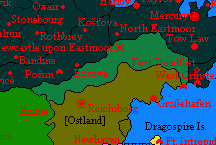Treaty of Port Moorland
BETWEEN THE
KINGDOM OF MOORLAND
AND THE
KINGDOM OF OSTLANDWherein the monarchs of both Moorland and Ostland desire peace following the War of Dispossession, both parties have agreed to the following terms:
Article I – Peace and friendship
There shall be a firm and perpetual state of peace and friendly relations between His Majesty, the King of Moorland and His Majesty, the King of Ostland, between Their Majesties' Heirs, Successors and Regents, and between the Kingdom of Moorland and the Kingdom of Ostland, in this treaty the High Contracting Parties, and between their Citizens, without discrimination.
Article II - Sovereignty and territorial integrity
Each High Contracting Party shall respect the independence, sovereignty and territorial integrity of the other party. The High Contracting Parties shall continue to develop and consolidate the relations of sincere friendship, good neighbourliness and comprehensive cooperation existing between them on the basis of the aforesaid principles as well as those of equality and mutual benefit.
Territorial integrity includes the territory of a High Contracting Party to the extent acknowledged and published by the Micronational Cartography Society. The territory extends 24 kilometres from the baseline coast of the High Contracting Party. Including the localities where the coastline is deeply indented and cut into, or if there is a fringe of islands along the coast in its immediate vicinity, the method of straight baselines joining appropriate points may be employed in drawing the baseline from which the breadth of the territorial sea is measured.
The reserve zone of a High Contracting Party extends 360 kilometres from the baseline coast. The economic and environmental resources within this zone belong fully to that High Contracting Party. In special situations where the territorial waters or the reserve zone of the High Contracting Parties would overlap, the line of separation will be drawn along the midpoint between the baseline of each High Contracting Party.
Article III - Airspace
Each High Contracting Party commits that any overflight of its airspace by aircraft registered upon the territory of the Other High Contracting Party, whose source and destination are outside the jurisdiction of the Overflown High Contracting Party and which make no intermediate landing upon the territory of the Overflown High Contracting Party, shall be considered to fall outside the remit of customs or immigration regulations and wholly outside the jurisdiction of any Third Parties, without prejudice to the exclusive right of the Overflown High Contracting Party to approve or deny such overflight as it sees fit.
The High Contracting Party can set up a Prohibited airspace, an overflight is strictly prohibited. The High Contracting Party informs about Prohibited airspace and appropriate punitive measures follow an overflight of an aircraft registered with the other High Contracting Party.
Article IV – Diplomatic mission
The High Contracting Parties will maintain regular contacts with each other on major international problems affecting the interests of both of their countries and governments by means of meetings, and exchanges of views between their leading statesmen, visits by official delegations and special envoys of the governments, and through diplomatic channels.
The High Contracting Party will make an embassy available for each other.
For the embassy, associated grounds, associated vehicles, leading statesmen, visits by official delegations, special envoys of the governments and ambassadors, diplomatic immunity applies.
Each High Contracting party recognizes and respects the procedures of acceptance by the ambassador, by handing over a letter of credence, which is addressed from one head of state to the other asking to give credence.
Article V - Recognition of bureaucracy
Each High Contracting Party gives to the other full faith and credit to all public acts, records, contracts and judicial proceedings in the field of civil law, including records and documents on marriage, property, titles, death and inheritance, in as much as any act, record, document, contract, proceeding is done according to the law.
Article VI - Interpretation
Any difference of interpretation of any Article or Articles of this Treaty which may arise between the High Contracting Parties will be settled bilaterally by peaceful means in a spirit of mutual respect and understanding.
Article VII - Ratification
This Treaty enters into force upon its signature and ratification by Both High Contracting Parties in accordance with their respective domestic procedures.
Article VIII - Port Moorland
In return for aid granted to the Kingdom of Ostland by the Kingdom of Moorland in ousting the foreign influence imposed over the former’s government during the War of Dispossession, Ostland agrees to cede the territory of Port Moorland to the Kingdom of Moorland as described in Appendix I.
Appendix I

Signed on 15.XII.1720 AN:
For the Kingdom of Moorland
His Majesty, Alpin MacMartin, King of Moorland
For the Kingdom of Ostland
Lord Protector of the Reich Generalfeldmarschall Otto von Eisenmann, Prince of Der Weißen Kiefern, Count of Eisenmann, Burgrave of Tollefichte